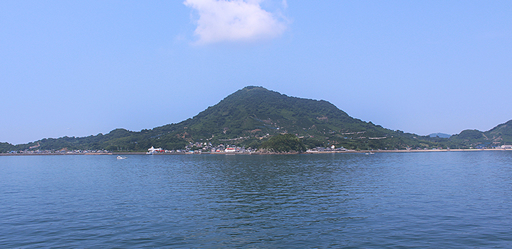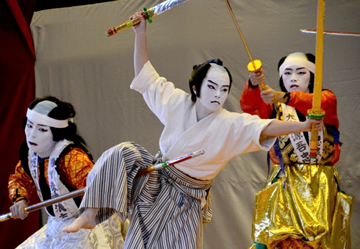


Gogoshima is the second largest island with a ria coastline. Enjoy marine sports and swimming on the white sandy beach.
Kofujiyama, which is the symbol of this island, is 282m high and nicknamed “Iyo Kofuji (small Fuji in Iyo Region)” because of the great shape of the mountain. The natural beauty of the mountain from season to season attracts visitors.
This island is famous for both fresh fish like flatfish, black rock fish, boiled and dried baby sardines and sweet mandarins nicknamed “Gogoshima Mandarins”.
Feel the unique history and culture from the traditional dance ”Funaodori (Fisher’s Dance)” and ”Shima Shikoku 88 Pilgrimage (a mimicry of Shikoku 88 Pilgrimage)“.

Once a year, the Kasane Stone on the Washigasu beach of Gogoshima Island shows a mysterious phenomenon. People can watch the sunset through a slit in the Kasane Stone around one of the twenty for seasons of the Japanese calendar known as “Rainwater” (Rainwater is a day when the orbit of the sun hits the middle of winter solstice and spring equinox). This mysterious phenomenon rarely happens due to weather conditions and the tide. Rainwater is usually the fifteenth day counting for the first day of spring, and it signifies “snow falling from the sky turning into rain, ice melting to water”.

The road towards the east in front of Yura port of Gogoshima Island will lead you to the Benzaiten Shrine, which is located further down the path that is protruding out to the ocean. Benzaiten, the only female of the Seven Gods of Good Fortune, is portrayed as a voluptuous beauty playing a Japanese lute known as Biwa. She is believed to be a God of happiness, prosperity, and the ability to progress. The small shrine with a white Torii gate is located next to the blue sea, just like an island itself. Every year on January 7th, a festival held on the island flourishes with neighbors and children. Similar to Daikokuten, the root of Benzaiten leads back to the God of water, Sarasvati, in ancient India. It is told that Benzaiten “bestows eloquence, infinite wisdom, wealth, and longevity”. It also “removes anything that perplexes people, such as nightmare, malice, dark magic, fierce god, and keeps away pain of sickness, illness and struggle”.

In 2009, an old/closed school was made good use of for people to interact by creating a place called “The Table of Island Gogoshima”. The theme of this location is to “learn the nature of the island, culture of the island and the life on the island to develop a future”. In the summer of 2013 a new café opened for people to enjoy and experience activities, such as music and art events, as well as development of local products. The idea of using an old school can bring back memories in a quiet relaxing space. Furthermore, the school yard is a great place for children to fully enjoy The Table of Island Gogoshima.

The Iwagami Shrine in Gogoshima Island is found in Umaiso district, which is located in the north of Yura port. An enshrined granite megalith, 5 meters tall with a 34 meter circumference, is said to carry the oldest daughter of Ooyamazumi God named “Iwanagahimenomikoto”. Iwanagahimenomikoto is worshiped as “Iwagamisama” by the local people.
Iwanagahimenomikoto is the daughter of Ooyamazumi God and the older sister of Konohanasakuyabime. According to the Japanese mythology (Kojiki・Nihonshoki (The Chronicles of Japan)), the lives of successive emperors are limited because Niniginomikoto, the ancestor god of emperor, chose the beautiful younger sister over Iwanagahimenomikoto. It is said that Gogoshima Island is left with abundant nature because anyone who cuts down a tree in Iwagami Shrine will be cursed.

When you go up a farm road behind Aikogahama beach of Gogoshima Island, you will see a magnificent view on top of the hill.
Beside the tree that says “Koibito Toge”, a bench is placed for lovers to cuddle close together and see the beautiful view. The blue sea and yellow Gazania flowers in full bloom will envelop visitors in the spring. This stunning location is also used in films. When a Japanese actor named Ohura Ryuichi once filmed in Koibito Toge with his son, they left a stone with a commemorative drawing. This special stone has been displayed in Koibito Toge ever since.
2 routes in operation to Tomari Port and Takahama Port
Takahama Port - Tomari Port (15 min)
Takahama Port - Yura Port (10 min)
Ferry Information : Gogoshima Co. Ltd.
There are a few accommodation facilities and grocery stores.
Vending machines are located close to the ferry port, the street along the coast and in front of Matsuyama City Hall Gogoshima Branch